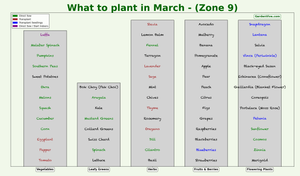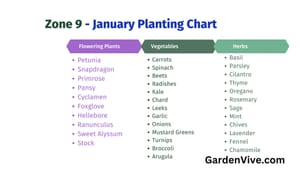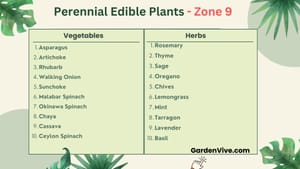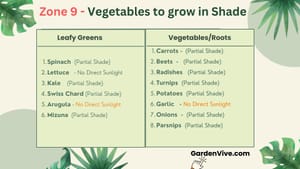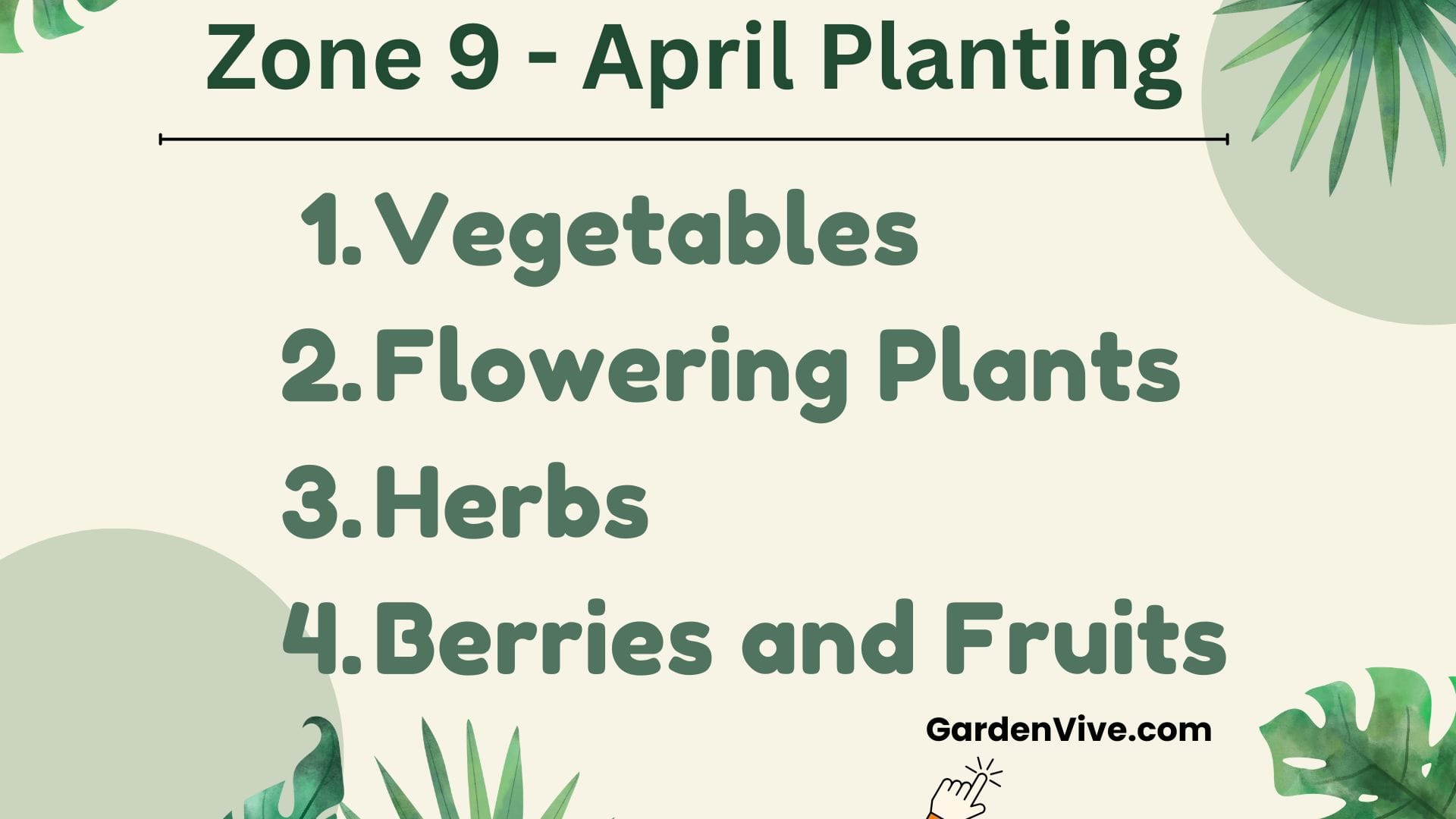
If you ask me what the prime month for gardening in Zone 9 is, I would say April. A lot of gardeners start in March, and that is totally fine. March remains cold, and there is a chance of frost (early in the month). This is why I suggest beginner gardeners start in April. In this article, you will find what to plant in April in Zone 9.
You can start warm-season veggies, herbs, fruit-berries, and flowering plants in April. This April planting guide for Zone 9 includes all of those.
My regular readers and subscribers already know the way I present the planting charts. This monthly planting chart for April includes all the plant types in an organized way. The charts will show the planting method and other necessary information.
Subscribe to this site to help me bring more content like this.
Let's start with leafy greens.
Leafy greens we can start in April in Zone 9
| Plant | Planting Method | Transplanting Time | Variety Recommendation | Spacing | Expected Harvesting Time |
|---|---|---|---|---|---|
| Lettuce | Direct seed or transplant | 2-3 weeks after seeding | Romaine, Buttercrunch | 8-12 inches apart | 45-60 days |
| Spinach | Direct seed | N/A | Bloomsdale, Space | 4-6 inches apart | 35-50 days |
| Kale | Direct seed or transplant | 4-6 weeks after seeding | Dwarf Curled, Lacinato | 12-18 inches apart | 50-70 days |
| Swiss Chard | Direct seed or transplant | 4-6 weeks after seeding | Bright Lights, Fordhook Giant | 12-18 inches apart | 50-60 days |
| Arugula | Direct seed | N/A | Rocket, Astro | 4-6 inches apart | 30-40 days |
| Mustard Greens | Direct seed | N/A | Southern Giant, Red Giant | 6-12 inches apart | 40-50 days |
| Bok Choy | Direct seed or transplant | 4-6 weeks after seeding | Tatsoi, Joi Choi | 6-12 inches apart | 45-60 days |
Vegetables to plant in April in Zone 9
| Plant | Planting Method | Transplanting Time | Variety Recommendation | Spacing | Expected Harvesting Time |
|---|---|---|---|---|---|
| Tomatoes | Transplant | After last frost | Roma, Cherry, Beefsteak | 18-24 inches apart | 60-80 days |
| Peppers | Transplant | After last frost | Bell, Jalapeño, Banana | 12-18 inches apart | 60-90 days |
| Cucumbers | Direct seed or transplant | 2-3 weeks after seeding | Marketmore, Boston Pickling | 12-24 inches apart | 50-70 days |
| Squash (Zucchini) | Direct seed | N/A | Black Beauty, Cocozelle | 24-36 inches apart | 45-60 days |
| Carrots | Direct seed | N/A | Nantes, Danvers | 2-3 inches apart | 60-80 days |
| Beets | Direct seed | N/A | Detroit Dark Red, Golden | 3-4 inches apart | 50-70 days |
| Radishes | Direct seed | N/A | Cherry Belle, French Breakfast | 2-3 inches apart | 25-40 days |
| Eggplant | Transplant | After last frost | Black Beauty, Ichiban | 18-24 inches apart | 70-90 days |
| Sweet Potatoes | Slips | After soil warms | Beauregard, Georgia Jet | 12-18 inches apart | 90-120 days |
Here's I have created a visual chart that will show you all the leafy greens and vegetables sorted by their harvesting time (in days)
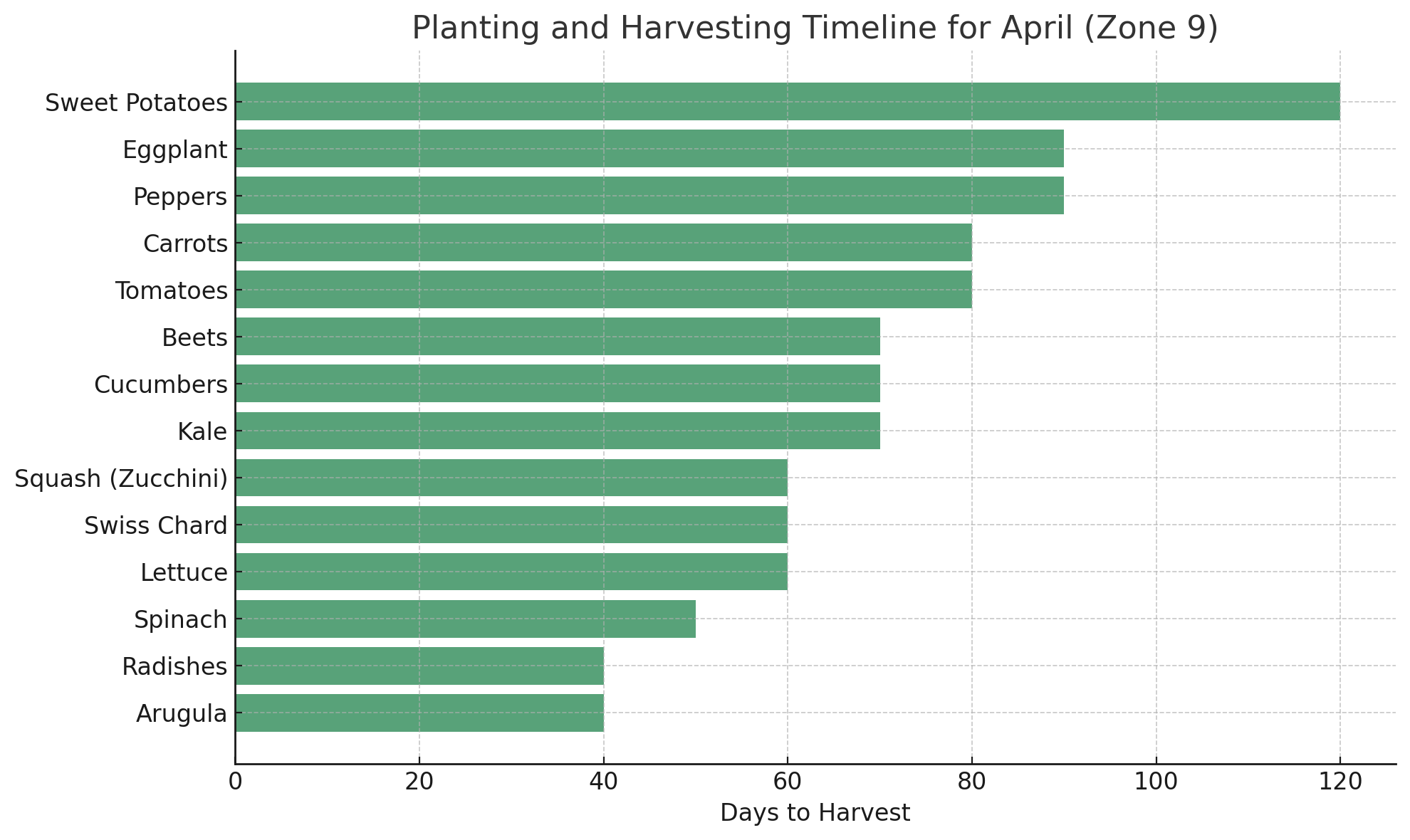
You can see that sweet potatoes will take the longest time to harvest, and radish, arugula will take the shortest time.
Note: Make sure you build proper Trellis for vining cucumbers.
both Marketmore and Boston Pickling cucumbers are vining varieties.
If you want to grow cucumber on the ground and do not have trellis go for "Bush Champion" variety. It will grow well in Zone 9 if planted in April.
Flowering plants to start planting in April - Zone 9
| Plant | Planting Method | Perennial or Annual | Fragrance | Blooming Time |
|---|---|---|---|---|
| Marigold | Direct seed or transplant | Annual | No | Spring to Fall |
| Zinnia | Direct seed | Annual | No | Summer to Fall |
| Lavender | Transplant | Perennial | Yes | Spring to Summer |
| Petunia | Transplant | Annual | Yes | Spring to Fall |
| Sunflower | Direct seed | Annual | No | Summer to Fall |
| Salvia | Transplant | Perennial | Yes | Spring to Fall |
| Cosmos | Direct seed | Annual | No | Summer to Fall |
| Snapdragon | Transplant | Annual | Yes | Spring to Summer |
| Geranium | Transplant | Perennial | Yes | Spring to Fall |
| Alyssum | Direct seed or transplant | Annual | Yes | Spring to Fall |
| Coreopsis | Direct seed | Perennial | No | Spring to Summer |
| Foxglove | Transplant | Biennial | Yes | Spring to Early Summer |
| Verbena | Direct seed or transplant | Perennial | Yes | Spring to Fall |
Herbs
| Plant | Planting Method | Perennial or Annual | Fragrance | Variety Recommendation |
|---|---|---|---|---|
| Basil | Direct seed or transplant | Annual | Yes | Genovese, Thai |
| Rosemary | Transplant | Perennial | Yes | Tuscan Blue, Arp |
| Thyme | Transplant | Perennial | Yes | English, Lemon |
| Oregano | Transplant | Perennial | Yes | Greek, Italian |
| Chives | Direct seed or transplant | Perennial | Yes | Common, Garlic |
| Dill | Direct seed | Annual | Yes | Bouquet, Fernleaf |
| Mint | Transplant | Perennial | Yes | Peppermint, Spearmint |
| Cilantro | Direct seed | Annual | Yes | Santo, Leisure |
| Sage | Transplant | Perennial | Yes | Common, Pineapple |
| Parsley | Direct seed or transplant | Biennial | Yes | Curly, Italian Flat-Leaf |
If you do not want to plant herbs in a separate space, have a look at this companion planting chart for vegetable garden.
Fruits and berries - April planting guide
| Plant | Planting Method | Perennial or Annual | Variety Recommendation | First Harvesting Time (Years) |
|---|---|---|---|---|
| Strawberry | Transplants or bare-root | Perennial | Chandler, Seascape | 1 year |
| Blueberry | Transplants | Perennial | Southern Highbush, Rabbiteye | 2-3 years |
| Blackberry | Transplants or bare-root | Perennial | Natchez, Arapaho | 1-2 years |
| Raspberry | Transplants or bare-root | Perennial | Heritage, Fall Gold | 1-2 years |
| Fig | Transplants | Perennial | Celeste, Brown Turkey | 2-3 years |
| Grapes | Transplants or bare-root | Perennial | Flame Seedless, Thompson Seedless | 2-3 years |
| Pomegranate | Transplants | Perennial | Wonderful, Angel Red | 2-3 years |
| Citrus (Lemon, Orange, Lime) | Transplants | Perennial | Meyer Lemon, Valencia Orange, Persian Lime | 3-5 years |
| Peach | Transplants | Perennial | Florida Prince, Tropic Beauty | 2-4 years |
| Apple | Transplants | Perennial | Anna, Dorsett Golden | 3-5 years |
I have seen gardeners use some specific fertilizers for specific fruit trees. If you try to feed your plants according to their growth stage, they will perform much better.
Once you finish April planting, you can follow this fertilizing guideline I created few months back: homemade fertilizers for fruit trees based on growth stages.
Note: Planting multiple suitable pollinating varieties can increase harvesting yield.
Note: It's better to follow location specific charts instead of Zone Specific charts. If you are from Florida you can find Florida's chart on this website separately.

